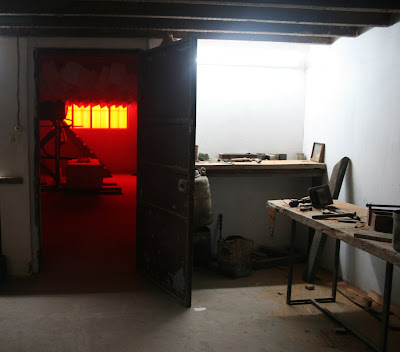 |
| Kathryn Campbell Dodd - A spoon is a spoon is a spoon... |
Last week I spent five days at the
Venice Biennale during the opening week. I went partly to see my own work in situ at
Rhodio, an artist-led group show in a restaurant,
Pane Vino e San Daniele in Dorsoduro. The show ran from 30 May to 4 June and involved the work of 13 installation artists from Wales making an intervention into the space.
 |
| Kathryn Campbell Dodd - A spoon is a spoon is a spoon (detail) |
At first sight the restaurant space looked fairly untouched, other than the white cloths that
Roger Lougher (the curator) had draped across the ornaments and objects belonging to the owners that had been left in situ, a subtle way of directing the visitor's attention to the works that were operating as 'art' in the space. The show was not invigilated, and visitors were left to find their own way around the work with the help of 'table talkers' - a small information sheet for each artist standing near the work.
I liked that quietness, the minimal impact on the environment. So much of the Venice Biennale shouts and jostles for attention, there was something rather subversive about the subtlety of the intervention. The Rhôd group of artists from whom those showing were selected, have been very much exploring ideas about 'place' - the urban rural dialogue; the centre and the periphery - and this was an interesting extension of that conversation. How does a loosely formed group of artists from urban Cardiff and rural west Wales take their discussion to a cultural hotspot like the biennale? What can we say about Wales in this unique place? How can we occupy a little corner of this exceptional art fair?
The show included work by: Michael Cousin, Ann Jordan, Kathryn Campbell Dodd, Mike Murray, good cop bad cop, Jason Pinder, Kim Fielding, David Shepherd, Richard Higlett, Elizabeth Waterhouse, Penny Jones, Jacob Whittaker. It was curated by Roger Lougher and presented by Mari Beynon Owen.
 |
| Jacob Whittaker - A Welsh Stream |
Jacob Whittaker, Cardigan based sound and video artist, installed three vinyl records in the show each tagged with a smart phone app that took you to his dedicated live webcasting site
A Welsh Stream, where you could access video from three locations in rural Wales including Melin Glonc where the
Rhôd series of shows have been held.
 |
| Richard Higlett |
Cardiff based artist
Richard Higlett used one of the sketches already in situ in the restaurant, a pencil sketch view of the Grand Canal, and created an inverted version of it as though a frogman's eye view of the scene and a comment on the popularity/folly of the biennale and the sinking of the city.
 |
| Penny Jones |
Penny Jones took a pair of 16th Century poems - one in Welsh, one in Italian - and created a menu for the restaurant which contained the two. Bawdy and sexually explicit, they are written by women in a man's world. She also redesigned the restaurant logo to depict three pregnant women - one pushing a buggy. During the exhibition Penny made a short performance piece in which she played with the androgyny of a composite character, part woman, part Gondolier.
 |
| Penny Jones |
Curator, Roger Lougher showed pieces from his series of altered health and safety signs.
 |
| Roger Lougher |

















